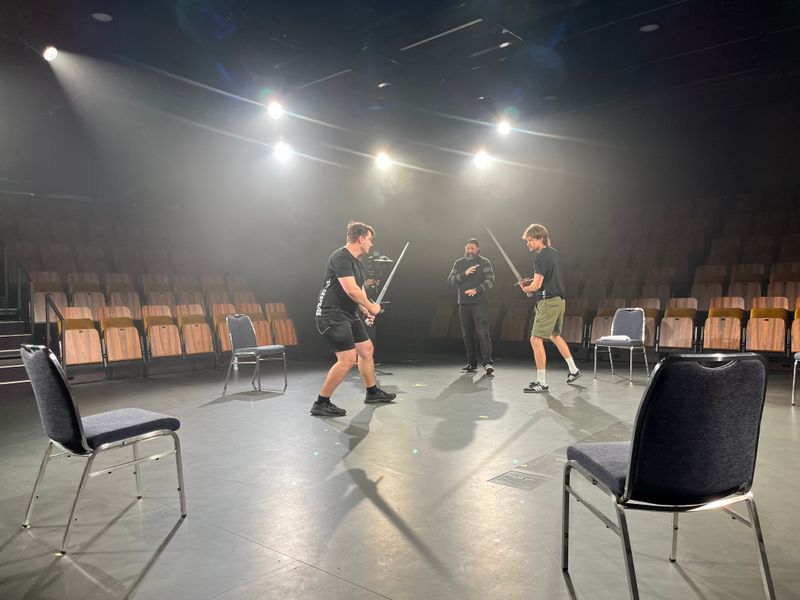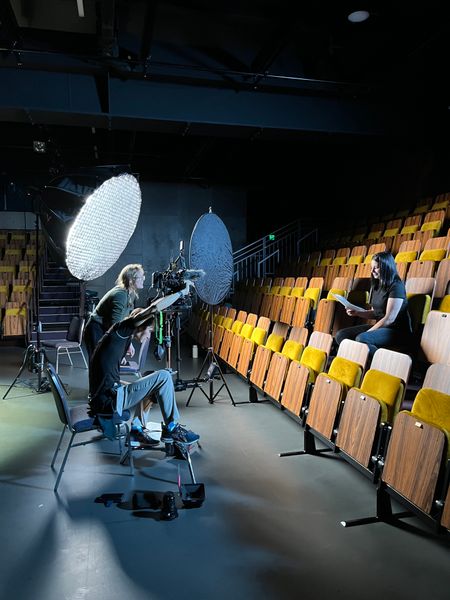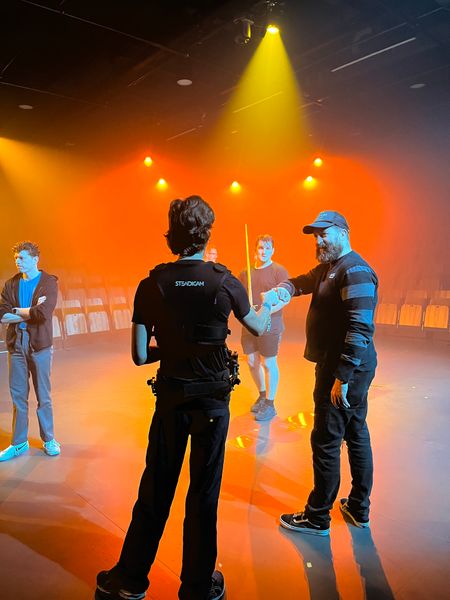



In recent years, Bell Shakespeare’s artistic team have been working on the development of a new, on-demand video resource for schools with the working title of In The Round. Designed to fulfill curriculum needs in an immersive, digital format, the videos will ensure all Australian students have access to Shakespeare in performance, regardless of their geographic location or socioeconomic challenges.
Head of Education Joanna Erskine, who is the writer for the project, shares how these video resources are developing, and the challenges encountered along the way.

While Bell Shakespeare’s national education program reaches more than 80,000 students face-to-face in 90% of federal electorates each year, there are many more who miss out, despite demand. As touring costs continue to escalate, digital resources become all the more important for schools.
Time is also a scarce resource for schools. Cramped curriculums, packed schedules and limited budgets are increasingly the norm. And yet, we know that many schools who study Shakespeare regularly spend five to six weeks reading his plays in class, out loud, one line at a time. We wanted to create a resource that teachers can use to take students through the plot of the play quickly, to allow their students more time to play and appreciate the depth and magic in these great works.
Film adaptations of Shakespeare, while useful, are not specific to the Australian Curriculum and do not support our own local industry. We wanted Australian students to hear Australian voices and see Australian artists in their own classrooms.
We decided to make a a suite of video resources that focus on plot, themes and language, and could each be viewed within a 40-minute school lesson. Bell Shakespeare actors would perform key text and original language, and a narrator would guide students using modern commentary.
And what would the films capture, exactly? We knew that recording a theatre production or a Players performance would not translate well to film, and would not have the depth of information students need. We explored how we could dramatise some of our existing classroom strategies, injecting them with performances from Bell Shakespeare actors. We discussed that we needed a hybrid of performance and analysis, to best suit teachers and students. It was clear we needed a video resource that would feel like students were in the room with the actors, viewing the play and performances from all angles, as if they were there.



In determining the format of the new resource, it was essential that it was repeatable and sustainable. We chose Macbeth as the first video, as it is arguably the most popular Shakespeare play for classroom study, with the most straightforward plot. So, beginning with Macbeth, our intention is to build up a bank of plays for schools over time.
While it sounds relatively simple in theory, creating a theatre/film hybrid has been extremely challenging. Several years ago we started playing with the idea with The Players in our old rehearsal room, using smartphones and company cameras. We continued to refine the idea and have now completed more than five creative developments to date, including script development.
Thanks to the support of the James N Kirby Foundation, in 2022 and 2023 we have been able to properly fund full creative developments with actors, crew, filmmakers and associated equipment hire. We transformed The Seed and The Neilson Nutshell into film studios, and got to work.
We are, of course, a theatre company. Filmmaking, whilst aligned with the theatre process, requires a completely different skillset. Our artistic concepts still needed to be tested with film experts. Shooting a scene that seemed straightforward on paper, could blow out to multiple camera angles requiring time, resources and people, impacting the budget and schedule. We went back to the drawing board again, and again, and again. This included testing a dolly track circling the set, before deciding we needed more flexibility and to be closer to the performers than the track would allow. The script changed and refined with every new decision, until we had a streamlined concept.



In June 2022 and November 2023 we undertook one-week creative developments and test shoots. We enlisted the expertise of Laura Turner, who has worked with Bell Shakespeare as a video designer on Hamlet and our 2019 schools' production of Macbeth. Importantly, Laura works across both theatre and film and so understands the unique language of each art form. Joining Laura was cinematographer Sam Heesen, who used a Steadicam camera which allowed us to get up close and personal with the performers, translating to the immersive feel we wanted. We set up The Neilson Nutshell in the round, so that students could see we were in a theatre space.
As Artistic Director Peter Evans said, we needed to work out how to “crack to code” and make a product that would be of artistic excellence, that met curriculum objectives, that came within budget, and could be captured within a week. With Laura and Sam, a number of Bell Shakespeare artists, Peter Evans, Joanna Erskine and the Bell Shakespeare team, we broke the script down and created a formula for capture. On our final day, Fight & Movement Director Nigel Poulton joined us to choreograph Macbeth and Macduff’s fight for screen.
With Laura Turner editing throughout the week we were able to quickly ascertain whether we had achieved what we set out to do artistically. And as we worked, we ran the maths on how long each shot took to capture and the personnel required, to make sure we were creating a repeatable, sustainable formula.
At this stage, it looks like we have indeed “cracked the code,” and are excited to capture the Macbeth resource videos in full in 2024.